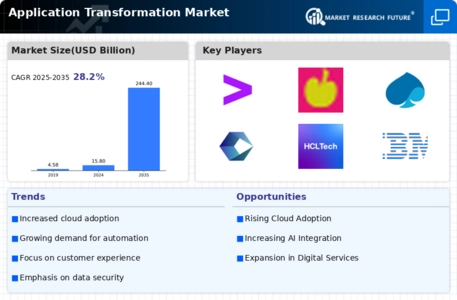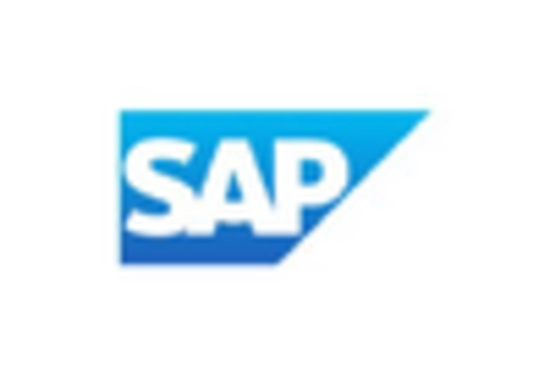-
EXECUTIVE SUMMARY
-
MARKET INTRODUCTION
-
2.1.
-
Definition
-
Scope of the Study
- Research Objective
- Limitations
-
2.2.2.
-
Assumptions
-
RESEARCH METHODOLOGY
-
Overview
-
Data Mining
-
Secondary Research
-
Primary Research
- Breakdown of Primary
-
3.4.1.
-
Primary Interviews and Information Gathering Process
-
Respondents
-
Forecasting Model
-
Market Size Estimation
- Top-Down Approach
-
3.6.1.
-
Bottom-Up Approach
-
Data Triangulation
-
Validation
-
MARKET DYNAMICS
-
Overview
-
Drivers
-
Restraints
-
Opportunities
-
MARKET FACTOR ANALYSIS
-
5.1.
-
Value Chain Analysis
-
Porter’s Five Forces Analysis
- Bargaining
- Bargaining Power of Buyers
- Threat of
- Threat of Substitutes
- Intensity of Rivalry
-
Power of Suppliers
-
New Entrants
-
COVID-19 Impact Analysis
- Market Impact Analysis
- Opportunity and Threat Analysis
-
5.3.2.
-
Regional Impact
-
GLOBAL APPLICATION
-
TRANSFORMATION MARKET, BY SERVICE
-
Overview
-
Portfolio Assessment
-
Cloud Migration
-
Replatforming
-
Integration
-
UI
-
Modernization
-
Post Modernization
-
GLOBAL APPLICATION TRANSFORMATION
-
MARKET, BY ORGANIZATION SIZE
-
Overview
-
Small and Medium-Sized
-
Businesses
-
Large Enterprises
-
GLOBAL APPLICATION TRANSFORMATION
-
MARKET, BY VERTICAL
-
Overview
-
Retail
-
IT and Telecommunication
-
Healthcare
-
Banking, Financial Services, and Insurance
-
8.6.
-
Government
-
Manufacturing
-
GLOBAL VERTICAL TRANSFORMATION MARKET,
-
BY REGION
-
Overview
-
North America
- U.S.
-
9.2.2.
-
Canada
-
Europe
- Germany
- France
- U.K
- Italy
- Spain
- Rest of Europe
-
Asia-Pacific
- China
- India
- Japan
- South Korea
- Rest of Asia-Pacific
-
9.4.5.
-
Australia
-
Rest of the World
- Africa
- Latin America
-
9.5.1.
-
Middle East
-
COMPETITIVE LANDSCAPE
-
Overview
-
Competitive Analysis
-
Market Share Analysis
-
Major Growth Strategy in the Global Vertical Transformation Market,
-
10.5.
-
Competitive Benchmarking
-
Leading Players in Terms of Number of Developments
-
in the Global Vertical Transformation Market,
-
Key developments and Growth
- New Service Launch/Organization Size Deployment
- Joint Ventures
-
Strategies
-
10.7.2.
-
Merger & Acquisitions
-
Major Players Financial
- Sales & Operating Income, 2022
- Major Players
-
Matrix
-
R&D Expenditure. 2022
-
COMPANY PROFILES
-
Accenture
- Financial Overview
- Product Offered
- Key Developments
- SWOT Analysis
- Key Strategies
-
11.1.1.
-
Company Overview
-
Atos S.E.
- Company Overview
- Financial Overview
- Product Offered
- Key Developments
- SWOT Analysis
- Key Strategies
-
Bell Integrator
- Company Overview
- Financial Overview
- Product Offered
- Key Developments
- SWOT Analysis
- Key Strategies
-
Capgemini
- Financial Overview
- Product Offered
- Key Developments
- SWOT Analysis
- Key Strategies
-
11.4.1.
-
Company Overview
-
Cognizant
- Company Overview
- Financial Overview
- Product Offered
- Key Developments
- SWOT Analysis
- Key Strategies
-
FUJITSU
- Company Overview
- Product Offered
- Key Developments
- SWOT Analysis
- Key Strategies
-
11.6.2.
-
Financial Overview
-
HCL Technologies
- Company Overview
- Financial Overview
- Key Developments
- SWOT Analysis
-
Limited
-
11.7.3.
-
Product Offered
-
11.7.6.
-
Key Strategies
-
IBM
- Company Overview
- Financial
- Product Offered
- Key Developments
- Key Strategies
-
Overview
-
11.8.5.
-
SWOT Analysis
-
Infosys Limited
- Financial Overview
- Product Offered
- Key Developments
- SWOT Analysis
- Key Strategies
-
11.9.1.
-
Company Overview
-
Microsoft
- Company Overview
- Financial Overview
- Product Offered
- Key Developments
- SWOT Analysis
- Key Strategies
-
Micro Focus
- Company Overview
- Financial Overview
- Product Offered
- Key Developments
- SWOT Analysis
- Key Strategies
-
Orcale
- Financial Overview
- Product Offered
- Key Developments
- SWOT Analysis
- Key Strategies
-
11.12.1.
-
Company Overview
-
Trianz
- Company Overview
- Financial Overview
- Product Offered
- Key Developments
- SWOT Analysis
- Key Strategies
-
Tech Mahindra Limited
- Company
- Financial Overview
- Product Offered
- SWOT Analysis
- Key Strategies
- Company Overview
- Financial
- Product Offered
- Key Developments
- Key Strategies
-
Overview
-
11.14.4.
-
Key Developments
-
11.15.
-
Hexaware Technologies Limited
-
Overview
-
11.15.5.
-
SWOT Analysis
-
Tata Consultancy Services
- Company Overview
- Financial Overview
- Key Developments
- SWOT Analysis
-
Limited
-
11.16.3.
-
Product Offered
-
11.16.6.
-
Key Strategies
-
APPENDIX
-
References
-
Related Reports
-
-
LIST OF TABLES
-
GLOBAL VERTICAL TRANSFORMATION MARKET,
-
SYNOPSIS, 2018-2032
-
GLOBAL VERTICAL TRANSFORMATION MARKET, ESTIMATES
-
& FORECAST, 2018-2032 (USD BILLION)
-
GLOBAL VERTICAL TRANSFORMATION
-
MARKET, BY SERVICE, 2018-2032 (USD BILLION)
-
GLOBAL VERTICAL TRANSFORMATION
-
MARKET, BY ORGANIZATION SIZE, 2018-2032 (USD BILLION)
-
GLOBAL VERTICAL
-
TRANSFORMATION MARKET, BY VERTICAL, 2018-2032 (USD BILLION)
-
NORTH AMERICA
-
VERTICAL TRANSFORMATION MARKET, BY SERVICE, 2018-2032 (USD BILLION)
-
TABLE 7
-
NORTH AMERICA VERTICAL TRANSFORMATION MARKET, BY ORGANIZATION SIZE, 2018-2032 (USD
-
BILLION)
-
NORTH AMERICA VERTICAL TRANSFORMATION MARKET, BY VERTICAL,
-
NORTH AMERICA VERTICAL TRANSFORMATION MARKET,
-
BY COUNTRY, 2018-2032 (USD BILLION)
-
U.S. VERTICAL TRANSFORMATION MARKET,
-
BY SERVICE, 2018-2032 (USD BILLION)
-
U.S. VERTICAL TRANSFORMATION MARKET,
-
BY ORGANIZATION SIZE, 2018-2032 (USD BILLION)
-
U.S. VERTICAL TRANSFORMATION
-
MARKET, BY VERTICAL, 2018-2032 (USD BILLION)
-
CANADA VERTICAL TRANSFORMATION
-
MARKET, BY SERVICE, 2018-2032 (USD BILLION)
-
CANADA VERTICAL TRANSFORMATION
-
MARKET, BY ORGANIZATION SIZE, 2018-2032 (USD BILLION)
-
CANADA VERTICAL
-
TRANSFORMATION MARKET, BY VERTICAL, 2018-2032 (USD BILLION)
-
EUROPE
-
VERTICAL TRANSFORMATION MARKET, BY SERVICE, 2018-2032 (USD BILLION)
-
TABLE 17
-
EUROPE VERTICAL TRANSFORMATION MARKET, BY ORGANIZATION SIZE, 2018-2032 (USD BILLION)
-
EUROPE VERTICAL TRANSFORMATION MARKET, BY VERTICAL, 2018-2032 (USD BILLION)
-
EUROPE VERTICAL TRANSFORMATION MARKET, BY COUNTRY, 2018-2032 (USD BILLION)
-
GERMANY VERTICAL TRANSFORMATION MARKET, BY SERVICE, 2018-2032 (USD BILLION)
-
GERMANY VERTICAL TRANSFORMATION MARKET, BY ORGANIZATION SIZE, 2018-2032
-
(USD BILLION)
-
GERMANY VERTICAL TRANSFORMATION MARKET, BY VERTICAL,
-
FRANCE VERTICAL TRANSFORMATION MARKET, BY
-
SERVICE, 2018-2032 (USD BILLION)
-
FRANCE VERTICAL TRANSFORMATION MARKET,
-
BY ORGANIZATION SIZE, 2018-2032 (USD BILLION)
-
FRANCE VERTICAL TRANSFORMATION
-
MARKET, BY VERTICAL, 2018-2032 (USD BILLION)
-
ITALY VERTICAL TRANSFORMATION
-
MARKET, BY SERVICE, 2018-2032 (USD BILLION)
-
ITALY VERTICAL TRANSFORMATION
-
MARKET, BY ORGANIZATION SIZE, 2018-2032 (USD BILLION)
-
ITALY VERTICAL
-
TRANSFORMATION MARKET, BY VERTICAL, 2018-2032 (USD BILLION)
-
SPAIN
-
VERTICAL TRANSFORMATION MARKET, BY SERVICE, 2018-2032 (USD BILLION)
-
TABLE 30
-
SPAIN VERTICAL TRANSFORMATION MARKET, BY ORGANIZATION SIZE, 2018-2032 (USD BILLION)
-
SPAIN VERTICAL TRANSFORMATION MARKET, BY VERTICAL, 2018-2032 (USD BILLION)
-
U.K VERTICAL TRANSFORMATION MARKET, BY SERVICE, 2018-2032 (USD BILLION)
-
U.K VERTICAL TRANSFORMATION MARKET, BY ORGANIZATION SIZE, 2018-2032 (USD
-
BILLION)
-
U.K VERTICAL TRANSFORMATION MARKET, BY VERTICAL, 2018-2032
-
(USD BILLION)
-
REST OF EUROPE VERTICAL TRANSFORMATION MARKET, BY SERVICE,
-
REST OF EUROPE VERTICAL TRANSFORMATION MARKET,
-
BY ORGANIZATION SIZE, 2018-2032 (USD BILLION)
-
REST OF EUROPE VERTICAL
-
TRANSFORMATION MARKET, BY VERTICAL, 2018-2032 (USD BILLION)
-
ASIA PACIFIC
-
VERTICAL TRANSFORMATION MARKET, BY SERVICE, 2018-2032 (USD BILLION)
-
TABLE 39
-
ASIA PACIFIC VERTICAL TRANSFORMATION MARKET, BY ORGANIZATION SIZE, 2018-2032 (USD
-
BILLION)
-
ASIA PACIFIC VERTICAL TRANSFORMATION MARKET, BY VERTICAL,
-
ASIA PACIFIC VERTICAL TRANSFORMATION MARKET,
-
BY COUNTRY, 2018-2032 (USD BILLION)
-
JAPAN VERTICAL TRANSFORMATION
-
MARKET, BY SERVICE, 2018-2032 (USD BILLION)
-
JAPAN VERTICAL TRANSFORMATION
-
MARKET, BY ORGANIZATION SIZE, 2018-2032 (USD BILLION)
-
JAPAN VERTICAL
-
TRANSFORMATION MARKET, BY VERTICAL, 2018-2032 (USD BILLION)
-
CHINA
-
VERTICAL TRANSFORMATION MARKET, BY SERVICE, 2018-2032 (USD BILLION)
-
TABLE 46
-
CHINA VERTICAL TRANSFORMATION MARKET, BY ORGANIZATION SIZE, 2018-2032 (USD BILLION)
-
CHINA VERTICAL TRANSFORMATION MARKET, BY VERTICAL, 2018-2032 (USD BILLION)
-
INDIA VERTICAL TRANSFORMATION MARKET, BY SERVICE, 2018-2032 (USD BILLION)
-
INDIA VERTICAL TRANSFORMATION MARKET, BY ORGANIZATION SIZE, 2018-2032
-
(USD BILLION)
-
INDIA VERTICAL TRANSFORMATION MARKET, BY VERTICAL, 2018-2032
-
(USD BILLION)
-
AUSTRALIA VERTICAL TRANSFORMATION MARKET, BY SERVICE,
-
AUSTRALIA VERTICAL TRANSFORMATION MARKET,
-
BY ORGANIZATION SIZE, 2018-2032 (USD BILLION)
-
AUSTRALIA VERTICAL TRANSFORMATION
-
MARKET, BY VERTICAL, 2018-2032 (USD BILLION)
-
SOUTH KOREA VERTICAL
-
TRANSFORMATION MARKET, BY SERVICE, 2018-2032 (USD BILLION)
-
SOUTH KOREA
-
VERTICAL TRANSFORMATION MARKET, BY ORGANIZATION SIZE, 2018-2032 (USD BILLION)
-
SOUTH KOREA VERTICAL TRANSFORMATION MARKET, BY VERTICAL, 2018-2032 (USD
-
BILLION)
-
REST OF ASIA-PACIFIC VERTICAL TRANSFORMATION MARKET, BY SERVICE,
-
REST OF ASIA-PACIFIC VERTICAL TRANSFORMATION
-
MARKET, BY ORGANIZATION SIZE, 2018-2032 (USD BILLION)
-
REST OF ASIA-PACIFIC
-
VERTICAL TRANSFORMATION MARKET, BY VERTICAL, 2018-2032 (USD BILLION)
-
TABLE
-
REST OF WORLD VERTICAL TRANSFORMATION MARKET, BY SERVICE, 2018-2032 (USD BILLION)
-
REST OF WORLD VERTICAL TRANSFORMATION MARKET, BY ORGANIZATION SIZE, 2018-2032
-
(USD BILLION)
-
REST OF WORLD VERTICAL TRANSFORMATION MARKET, BY VERTICAL,
-
REST OF WORLD VERTICAL TRANSFORMATION MARKET,
-
BY COUNTRY, 2018-2032 (USD BILLION)
-
MIDDLE EAST VERTICAL TRANSFORMATION
-
MARKET, BY SERVICE, 2018-2032 (USD BILLION)
-
MIDDLE EAST VERTICAL TRANSFORMATION
-
MARKET, BY ORGANIZATION SIZE, 2018-2032 (USD BILLION)
-
MIDDLE EAST
-
VERTICAL TRANSFORMATION MARKET, BY VERTICAL, 2018-2032 (USD BILLION)
-
TABLE
-
AFRICA VERTICAL TRANSFORMATION MARKET, BY SERVICE, 2018-2032 (USD BILLION)
-
AFRICA VERTICAL TRANSFORMATION MARKET, BY ORGANIZATION SIZE, 2018-2032
-
(USD BILLION)
-
AFRICA VERTICAL TRANSFORMATION MARKET, BY VERTICAL,
-
LATIN AMERICA VERTICAL TRANSFORMATION MARKET,
-
BY SERVICE, 2018-2032 (USD BILLION)
-
LATIN AMERICA VERTICAL TRANSFORMATION
-
MARKET, BY ORGANIZATION SIZE, 2018-2032 (USD BILLION)
-
LATIN AMERICA
-
VERTICAL TRANSFORMATION MARKET, BY VERTICAL, 2018-2032 (USD BILLION)
-
LIST
-
OF FIGURES
-
RESEARCH PROCESS
-
MARKET STRUCTURE FOR THE
-
GLOBAL VERTICAL TRANSFORMATION MARKET
-
MARKET DYNAMICS FOR THE GLOBAL
-
VERTICAL TRANSFORMATION MARKET
-
GLOBAL VERTICAL TRANSFORMATION MARKET,
-
SHARE (%), BY SERVICE, 2022
-
GLOBAL VERTICAL TRANSFORMATION MARKET,
-
SHARE (%), BY ORGANIZATION SIZE, 2022
-
GLOBAL VERTICAL TRANSFORMATION
-
MARKET, SHARE (%), BY VERTICAL, 2022
-
GLOBAL VERTICAL TRANSFORMATION
-
MARKET, SHARE (%), BY REGION, 2022
-
NORTH AMERICA: VERTICAL TRANSFORMATION
-
MARKET, SHARE (%), BY REGION, 2022
-
EUROPE: VERTICAL TRANSFORMATION
-
MARKET, SHARE (%), BY REGION, 2022
-
ASIA-PACIFIC: VERTICAL TRANSFORMATION
-
MARKET, SHARE (%), BY REGION, 2022
-
REST OF THE WORLD: VERTICAL TRANSFORMATION
-
MARKET, SHARE (%), BY REGION, 2022
-
GLOBAL VERTICAL TRANSFORMATION
-
MARKET: COMPANY SHARE ANALYSIS, 2022 (%)
-
ACCENTURE: FINANCIAL OVERVIEW
-
SNAPSHOT
-
ACCENTURE: SWOT ANALYSIS
-
ATOS S.E.: FINANCIAL
-
OVERVIEW SNAPSHOT
-
ATOS S.E.: SWOT ANALYSIS
-
BELL INTEGRATOR:
-
FINANCIAL OVERVIEW SNAPSHOT
-
BELL INTEGRATOR: SWOT ANALYSIS
-
FIGURE
-
COGNIZANT: FINANCIAL OVERVIEW SNAPSHOT
-
COGNIZANT: SWOT ANALYSIS
-
CAPGEMINI.: FINANCIAL OVERVIEW SNAPSHOT
-
CAPGEMINI.: SWOT
-
ANALYSIS
-
FUJITSU: FINANCIAL OVERVIEW SNAPSHOT
-
FUJITSU:
-
SWOT ANALYSIS
-
INFOSYS LIMITED: FINANCIAL OVERVIEW SNAPSHOT
-
FIGURE
-
INFOSYS LIMITED: SWOT ANALYSIS
-
IBM: FINANCIAL OVERVIEW SNAPSHOT
-
IBM: SWOT ANALYSIS
-
INFOSYS LIMITED: FINANCIAL OVERVIEW
-
SNAPSHOT
-
INFOSYS LIMITED: SWOT ANALYSIS
-
MICROSOFT:
-
FINANCIAL OVERVIEW SNAPSHOT
-
MICROSOFT: SWOT ANALYSIS
-
FIGURE
-
MICRO FOCUS: FINANCIAL OVERVIEW SNAPSHOT
-
MICRO FOCUS: SWOT ANALYSIS
-
ORCALE: FINANCIAL OVERVIEW SNAPSHOT
-
ORCALE: SWOT ANALYSIS
-
TRIANZ: FINANCIAL OVERVIEW SNAPSHOT
-
TRIANZ: SWOT ANALYSIS
-
TECH MAHINDRA LIMITED: FINANCIAL OVERVIEW SNAPSHOT
-
TECH
-
MAHINDRA LIMITED: SWOT ANALYSIS
-
HEXAWARE TECHNOLOGIES LIMITED: FINANCIAL
-
OVERVIEW SNAPSHOT
-
HEXAWARE TECHNOLOGIES LIMITED: SWOT ANALYSIS
-
TATA CONSULTANCY SERVICES LIMITED: FINANCIAL OVERVIEW SNAPSHOT
-
FIGURE
-
TATA CONSULTANCY SERVICES LIMITED: SWOT ANALYSIS










Leave a Comment